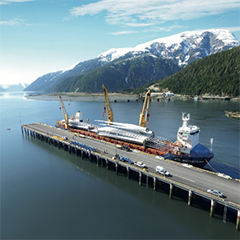Mads Poulsen, Sales and Chartering Manager, BBC Chartering, Esbjerg, got together with PES to share his optimism on the outlook for the wind industry. He also talks about working with the bigger and bigger component sizes we are seeing today. Their worldwide offices mean they are more than well positioned to meet their customers’ needs.
PES: Welcome back to PES Wind magazine. Thanks for talking with us. For the benefit of our new readers would you like to begin by explaining a little about the background of BBC Chartering and the importance of the wind industry to you?
Mads Poulsen: Thank you. It´s always a pleasure talking to PES. As a project carrier, a large share of our cargo volume is energy-related project commodities. Wind energy has, for many years, been a key commodity for our business. We are convinced that wind power will continue its increasing importance for BBC Chartering as most countries follow policies to move towards greener energy capacity.
Of course, we follow the industry developments with keen interest and learn about the industry’s future logistic needs and evaluate how we at BBC can best support the efforts.
PES: Are you experiencing more growth in the market?
MP: Green energy continues to expand globally. Although growth has come down since its peak in 2015, there was an installed capacity of about 52GW in 2017 and a total installed capacity of 539.6GW. Growth is also coming from the offshore wind market, albeit at comparably lower levels. With about 4.4 GW capacity added in 2017, this segment experienced its biggest growth ever.
But it’s not just the installed capacity which drives the market. Over the years, we have seen the component sizes grow and, with that, weight per turbine, especially in the offshore market. So, overall, we believe the wind industry continues to have strong prospects and we will continue to offer highly competitive and tailor made transport solutions for the industry.
PES: We know that BBC Chartering has various branches worldwide involved in wind power; we would like to know how they fit in with the company and what roles they have?
MP: Our main offices involved in wind power are Houston, Singapore, Bilbao, Bremen, Esbjerg, and Leer. Through close collaboration between these offices, we learn about upcoming projects and the customer’s service requirements. We then develop and offer project-specific solutions in response to their needs. Depending on the respective challenge, this could be a spot transport solution, an integrated approach to logistics, or the delivery of a volume contract.
Primarily, the offices are where the customers are. The office in Leer is our global head office. From here, we manage our global vessel operations. Singapore and Houston are regional head offices that coordinate the activities of the satellite offices in the respective regions. All offices maintain close customer relationships. Some are closer to decision makers while others are more active on the cargo handling side. But, all follow one goal: provide the best transport solution to our customers.



























